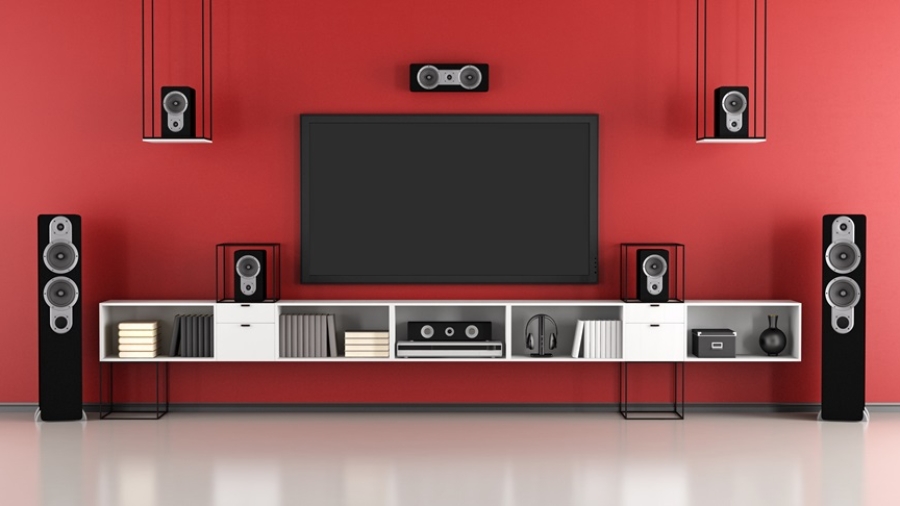In-Wall Home Theater Speakers
Table of Contents
ToggleCreating an immersive and cinematic experience is a primary objective in the home entertainment business, and the audio system plays a vital role in achieving it. Nowadays, in-wall home theater speakers are gaining popularity because of their ability to blend in with the decor while giving an immersive audio experience. These speakers provide a fashionable and modern alternative to audio needs without losing sound quality. The trend toward minimalist and clutter-free living spaces has heightened the attractiveness of in-wall speakers, which can be installed into walls to free up floor space for other furniture or design elements.
Ambrosic Home Theater Designs, LLC are experts in providing the best in-wall home theater speakers for every space. With long years in the home entertainment industry, Ambrosic Home Theater Designs, LLC has been a trusted brand for South Carolina homes. Feel free to connect with them for your home entertainment needs.
Call Ambrosic Home Theater Designs, LLC
What Are the Factors to Consider When Choosing In-Wall Home Theater Speakers

-
Sound Quality
Before getting into the aesthetics and design, it’s critical to emphasize sound quality. Look for speakers with a clean and balanced audio experience across all frequency ranges. Consider the speakers’ power handling, sensitivity, and frequency response.
-
Room Size and Acoustics
The size and acoustics of your space have a significant impact on how in-wall speakers work. Larger rooms may need more powerful speakers, and acoustics influence sound reflection and absorption. Understanding your room’s qualities will help you choose speakers that fit the environment.
-
Easy Installation
The installation procedure might be challenging, as in-wall speakers have a sleek, discreet look. Consider if you will do the installation yourself or hire a professional. Some speakers come with simple installation instructions, making the DIY option possible for individuals with intermediate handyman skills. However, asking for help from a professional is still the best option to ensure a correct installation.
-
Aesthetic and Design
In-wall speakers are designed to merge effortlessly into your living area, not only provide sound. Consider the speakers’ style and finish to match your space’s decor. Some speakers even include paint modification options.
-
Speaker Type
In-wall speakers are classified into three types: main speakers, surround speakers, and subwoofers, each having a distinct function in creating a dramatic soundtrack within your home theater.
-
Main speakers
The main speakers produce most of the audio output, including conversation, music, and principal sound effects. Choosing high-quality primary speakers provides a clean and dramatic audio foundation for your home theater.
-
Surround Speakers
Surround speakers play an essential part in producing a three-dimensional soundscape. They immerse you in the auditory experience, letting you hear noises from all angles. Strategically arranging surround speakers improves movie realism and produces an engulfing experience.
-
Subwoofers
Subwoofers are intended to recreate low-frequency sounds, adding depth to explosions, rumbling engines, and dramatic musical compositions. When installed appropriately, in-wall subwoofers provide a discreet alternative for producing strong bass without needing large external equipment.
Understanding the duties of each speaker type enables you to design a well-balanced and dynamic audio setup based on your tastes and the needs of your preferred entertainment material.
How Audio Calibration and
Integration Impact Sound Quality
Finding and installing high-quality in-wall speakers is crucial to a great home theater experience, but immersion goes beyond the speakers. It entails a thorough calibration and integration procedure in which each component works together to maximize the performance of your audio system.

1. Understanding Calibration
Calibration involves fine-tuning your audio system’s performance. Calibration ensures that in-wall speakers deliver a consistent and balanced audio experience. Here are some reasons why calibration is important:
-
Adjusting Acoustics
Your in-wall speakers may be calibrated to match your room’s acoustics. Size, shape, and material affect acoustics in every room. Calibration compensates for these variances, making your speakers sound true.
-
Acoustic Anomalies Removal
Acoustic resonances and reflections may result from in-wall installations. Some high-end AV receivers have calibration tools to detect and fix these abnormalities. The result is a clearer, more immersive sound without distortions.
-
Optimizing Speaker Location
Calibration entails perfecting the positioning of each in-wall speaker in your space. It ensures that all speaker sound waves reach your listening area simultaneously, creating a seamless audio experience. This strategy increases sound localization, letting you hear the material as intended.
-
Regulating Frequency Response
Your speakers produce sound at different frequencies. Each speaker’s frequency response is calibrated to prevent one frequency from dominating. This produces a balanced, realistic sound profile for music and movies.
-
Room Correction Systems
Advanced room correction is available in several AV receivers. Advanced algorithms automatically adjust speaker settings based on your room’s acoustics. Above and beyond calibration, room correction optimizes sound quality.
2. Understanding Integration
Integrating all audio system components into a harmonious symphony goes beyond speakers. In-wall speakers, AV receivers, subwoofers, and other audio equipment are included.
-
Compatible AV Receivers
The AV receiver, your audio system’s heart, must be perfectly connected to your in-wall speakers. Make sure your receiver and speakers are impedance and power management compliant. Well-matched mixes maximize performance without underpowering or overdriving speakers.
-
Integrating Subwoofer
Low-frequency impacts from subwoofers enhance your audio experience. Integration of subwoofers requires proper crossover frequencies and volume levels. Integration between in-wall speakers and subwoofers prevents bass dissonance.
-
Channel Level Balancing
For an immersive soundscape, channel levels must be balanced. Thus, each speaker—in-wall or otherwise—contributes proportionally to the audio mix. AV receivers let you alter channel levels to customize audio balance.
-
Sources and Connectivity
Blu-ray players, streaming gadgets, and gaming consoles should be considered. Ensure these components are compatible with your AV receiver and can offer high-quality audio signals for seamless integration. To guarantee audio chain signal integrity, use HDMI or optical connections.
-
Multi-Room Audio
Integration includes integrating in-wall speakers with multi-room audio installations. Use smart home technologies or multi-room audio systems to control and synchronize audio playback across zones.
Consider your audio system a symphony waiting for a conductor during calibration and integration. By calibrating your in-wall speakers, each instrument works in perfect harmony. Adding these speakers to your audio environment makes your space a music hall where every note is placed correctly and clearly.
In conclusion, home theater immersion extends beyond in-wall speakers. Remember that appropriately used, calibrated, and integrated in-wall home theater speakers produce a symphony.
Frequently Asked Questions
What Is the Difference Between In-Wall Home Theater Speakers and Standard Speakers?
The difference between in-wall home theater speakers and standard speakers is basically where they are installed. In-wall home theater speakers are audio speakers meant to be put directly into a room’s walls, offering a quiet and space-saving alternative for music playing. In-wall speakers, as opposed to standard floor or shelf speakers, are flush-mounted, giving them a cleaner and more integrated appearance.
What Are the Advantages of Installing In-Wall Home Theater Speakers?
The advantages of installing in-wall home theater speakers include:
- Space Saving: They don’t take up any floor space, making them excellent for small areas.
- Aesthetic appeal: In-wall speakers provide a sleek, unobtrusive look that blends in with any room design.
- Reduced Clutter: Wires and cables are concealed behind the walls to reduce visible clutter.
- Immersive Audio: When carefully positioned, in-wall speakers may help create a more immersive surround sound experience.
Can In-Wall Speakers Provide Comparable Audio Quality to Regular Speakers?
Yes, in-wall speakers can provide comparable audio quality to regular speakers. The goal is to select recognized brands and models with specs corresponding to your audio tastes. Power management, sensitivity, and frequency response are all critical factors to consider when deciding sound quality.

Audio and Video Services
by
Ambrosic Home Theater Designs, LLC
Choosing the right in-wall home theater speakers can be confusing, which is why we recommend you check out audio and video services by Ambrosic Home Theater Designs, LLC. We will work with you from consultation to installation to guarantee your home entertainment pleasure. We value functionality without sacrificing style. We can find the best audio system for your home entertainment system.
Contact Ambrosic Home Theater Designs, LLC
At (843) 338-5084 Today
Ambrosic Home Theater Designs, LLC
35 Wood Duck Court
Hilton Head Island, SC 29928
843-338-5084

